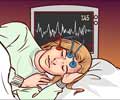Polysomnography, commonly known as sleep study is the gold standard for diagnosing and analyzing sleep-disordered breathing in children who are candidates for tonsillectomy, says study.

"Less than 10% of children get a sleep study before tonsillectomy," notes Richard M. Rosenfeld, MD, MPH, guideline author and consultant. "The polysomnography guideline will empower doctors and parents to get the right test for the right reasons, leading to safer surgery and better outcomes for children with tonsils that block their breathing while asleep."
The primary purpose of this guideline is to improve referral patterns for polysomnography among these patients. In creating this guideline, the American Academy of Otolaryngology Head and Neck Surgery Foundation selected a panel representing the fields of anesthesiology, pulmonology medicine, otolaryngology head and neck surgery, pediatrics, and sleep medicine.
Source-Eurekalert















